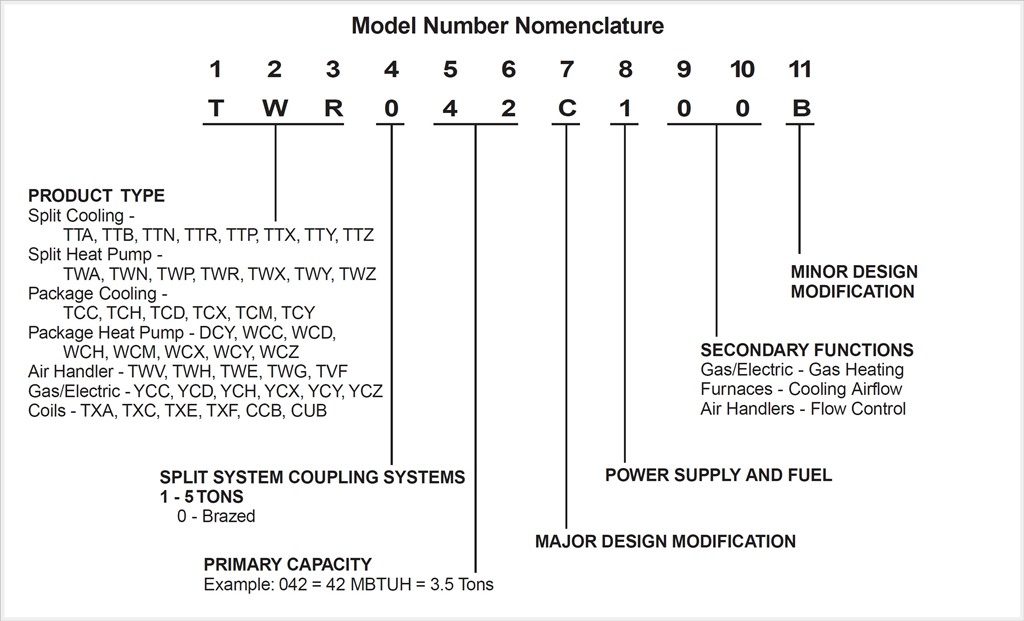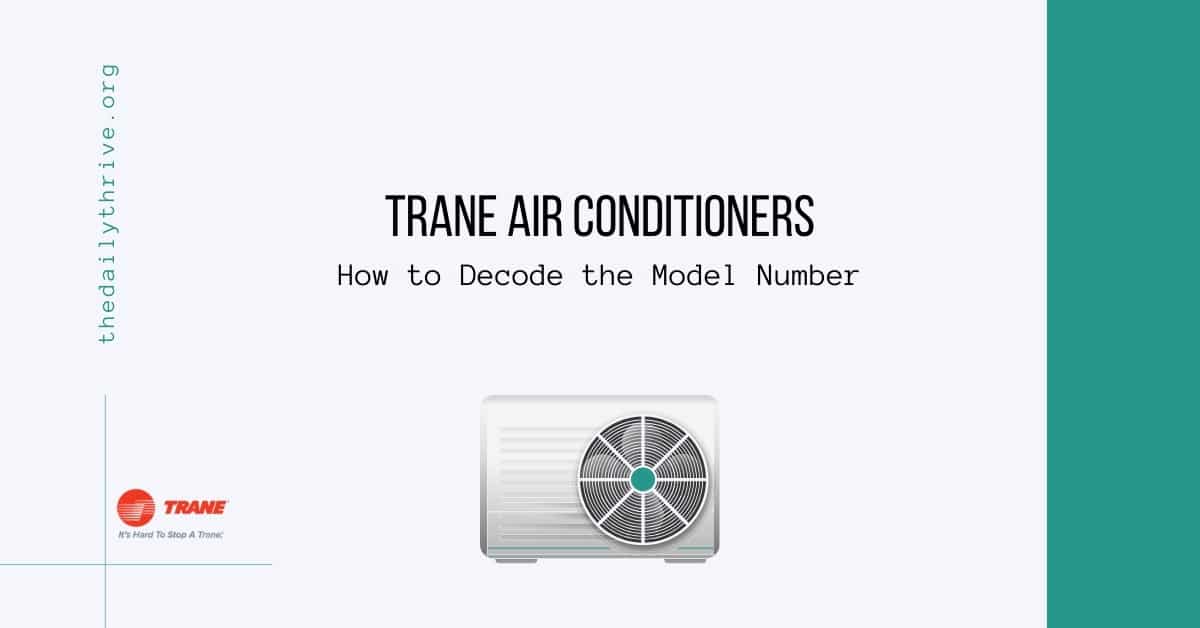Trane Model Number is used to breakdown or differentiate one product in a series from another. These numbers are commonly used in many different types of trane product. Letters are sometimes used along with numbers in the coding.
Your Trane model number isn’t just a random assortment of characters; it’s a treasure map to a wealth of information about your cooling system. Think of it as your HVAC user manual in code form. By understanding your model number, you’ll be able to make smarter decisions, save time, and ensure the longevity of your Trane unit.
The Trane Model Number of a product is often featured prominently on the packaging of said product. On the physical product itself, the model number is most commonly found on the front, rear or bottom of the product or in the manual pdf.
How to decode?
There is no standard format for how the letters and numbers are used. Trane heating and air conditioning companies are free to decide how they want to use the package unit model number.

Trane model number nomenclature split into several segments. Each segment will have assigned a number of letters and digits. Trane uses their model number to identify its use in the HVAC system.
- First letter: The model number starts with 4. This number represents the type of refrigerant the unit uses. 2 stands for R-22 and 4 stands for R410A.
- Second letter. T stands for Trane.
- The next 3 letter represents the product type. W stands for split heat pump and T stands for split cooling. The third letter equals the product family. Z = leadership – 2 stage, X = leadership, R = replacement/retail, B = basic, A = light commercial.
- The fifth number is for unit’s Seasonal Energy Efficiency Ratio. A single number represents the SEER: 0 = 10, 1 = 11, 2 = 12, 3 = 13, 4 = 14, 5 = 15, 6 = 16, 7 = 17, 8 = 18, 9 = 19.
- The six letter. Zero indicates the system’s connections are brazed or soldered.
- The seven and eight number indicate tonnage. How many BTUs the unit produces in thousands. For example: 36 = 36,000 BTUs.
- The nine letter represents the age. Any type of major modifications done to the system since it was originally manufactured explained here. Click here for more information on how to know the age of trane from serial number.
- Number ten indicates the power supply voltage. 1 = 200-230/1/60 or 208-230/1/60, 3 = 200-230/3/60, 4 = 460/3/60.
- The position eleven, twelve and thirteen. These numbers represent any secondary function.
- Position fourteen stands for minor design modifications
- The last letter is the unit part’s identifier code.
Examples of Trane Model Number
The Trane model is #TCD120C40CCA
TC: Package Cooling, Electric Heat
D: Downflow
120: 10 Tons, Standard Efficiency
C: Major Design Sequence
4: 460/60/3
0: ? (a description is not listed)
C: Downflow Economizer and Oversize Motor
C: Minor Design Sequence
A: Service Digit (i don’t know exactly what this means)
Trane RTU model #SXHEC9040E76AD8D3D01GGNRTX
S= Self Contained
X= DX cooling,Extended Casing
H= Single Zone
E= 5th Developement sequence
C90= 90 Tons
4= 460/60/3 XL
0= No Heat
E= Design Sequence
7= 100% Exhaust w/ statitrac & 15 hp motor
6= Ex fan Drive 600 RPM
A= Throw away filters
D= Supply Fan HP 40 ( 2-20HP)
8= Supply Fan Drive 800 RPM
D= !00% Economizer
3= VAV ( SA temp Control w/ IG Vanes)
D= BAYSENS014
O= Standard Ambient Control
1= UL Approval
Trane Tonnage from Model Number
- TTP018 = 1-1/2ton
- TTP024 = 2 ton
- TTP030 = 2 1/2 ton
- TTP036 = 3 ton
- TTP042 = 3 1/2 ton
- TTP048 = 4 ton
Example of Trane Model Identification
The Trane model number is #TWE030C140B0, let’s try to decode this model number:
- TW = split component heat pump compatable
- E = Electric furnace (like they said, heat strips are added in the field, could be anything from 10kw to 25 kw)
- 0 = Brazed refrigeration connection
- 30 = 2.5 ton like you mentioned
- C = Major development sequence C is standard system, E would be VS motor, P would be high eff system
- 1 = 220-230/1/60 (electric rating)
- 4 = Accurtron flow control check valve
- 0 = Standard insulation
- B = Minor design sequence (means nothing other than to the facotory)
- 0 = Service digit (they change these as they do “improvements” on thier stuff)
Your model number isn’t just a decoder ring for replacement parts. It can also help you troubleshoot issues and guide you through proper maintenance. It’s like having an HVAC whisperer right by your side. You’ll be able to handle small problems like a pro, and you’ll know when it’s time to call in reinforcements.
As the model number includes some vital information about your Trane HVAC unit. Use our guide above to decode the Trane model number. For more complex problems please contact the professionals HVAC technician. They will help you get the information you need and make sure you get the perfect solution for your whole HVAC system.
Decoding the Trane model number need patience and accuracy, focus on each segments and you’ll break the code quickly. If you have any issues with finding your model number or determining what it means, don’t hesitate to contact us.







I have a old RTU and the model number is SFHC-B306-LB. I need to find out the tonnage of the unit. Hope you can help me.
Thanks Rick Erickson